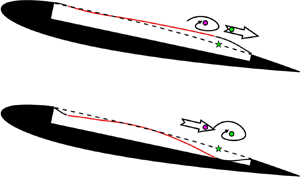Article contents
Aerodynamics and fluid–structure interaction of an airfoil with actively controlled flexible leeward surface
Published online by Cambridge University Press: 06 January 2023
Abstract

Piezoelectric macro-fibre composite (MFC) actuators are employed onto the flexible leeward surface of an airfoil for active control. Time-resolved aerodynamic forces, membrane deformations and flow fields are synchronously measured at low Reynolds number (Re = 6 × 104). Mean aerodynamics show that the actively controlled airfoil can achieve lift-enhancement and drag-reduction simultaneously in the angle of attack range of 10° ≤ α ≤ 14°, where the rigid airfoil encounters stall. The maximum increments of lift and lift-to-drag ratio are 27.1 % and 126 % at the reduced actuation frequency of  ${f^ + } = 3.52$. The unsteady coupling features are further analysed at α = 12°, where the maximum lift-enhancement occurs. It is newly discovered that the membrane vibrations and flow fields are locked into half of the actuation frequency when
${f^ + } = 3.52$. The unsteady coupling features are further analysed at α = 12°, where the maximum lift-enhancement occurs. It is newly discovered that the membrane vibrations and flow fields are locked into half of the actuation frequency when  ${f^ + } > 3$. The shift of the dominant vibration mode from bending to inclining is the reason for the novel ‘half-frequency lock-in’ phenomenon. To the fluid–structure interaction, there are three characteristic frequencies for the actively controlled airfoil:
${f^ + } > 3$. The shift of the dominant vibration mode from bending to inclining is the reason for the novel ‘half-frequency lock-in’ phenomenon. To the fluid–structure interaction, there are three characteristic frequencies for the actively controlled airfoil:  $S{t_1} = 0.5{f^ + }$,
$S{t_1} = 0.5{f^ + }$,  $S{t_2} = {f^ + }$, and
$S{t_2} = {f^ + }$, and  $S{t_3} = 1.5{f^ + }$. Here, St1 and its harmonics (St2, St3) are coupled with the natural frequencies of the leading-edge shear layer, resulting in the generation of multi-scale flow structures and suppression of flow separation. The lift presents comparable dominant frequencies between St1 and St3, which means the instantaneous lift is determined by the flow structures of St1 and St3. The local membrane bulge and dent affect the instantaneous swirl strength of flow structures near the maximum vibration amplitude location, which is the main reason for the variation of instantaneous lift.
$S{t_3} = 1.5{f^ + }$. Here, St1 and its harmonics (St2, St3) are coupled with the natural frequencies of the leading-edge shear layer, resulting in the generation of multi-scale flow structures and suppression of flow separation. The lift presents comparable dominant frequencies between St1 and St3, which means the instantaneous lift is determined by the flow structures of St1 and St3. The local membrane bulge and dent affect the instantaneous swirl strength of flow structures near the maximum vibration amplitude location, which is the main reason for the variation of instantaneous lift.
JFM classification
- Type
- JFM Papers
- Information
- Copyright
- © The Author(s), 2023. Published by Cambridge University Press
References
REFERENCES
- 11
- Cited by





